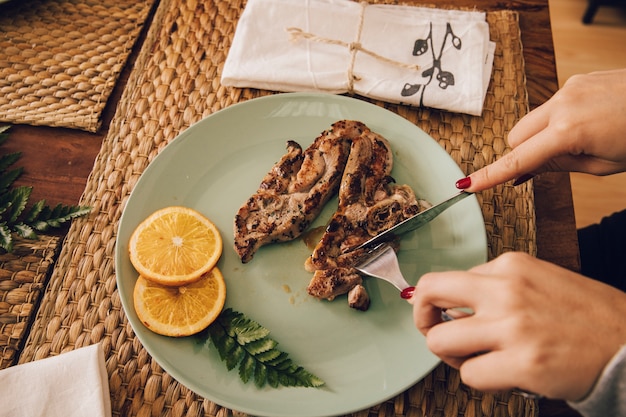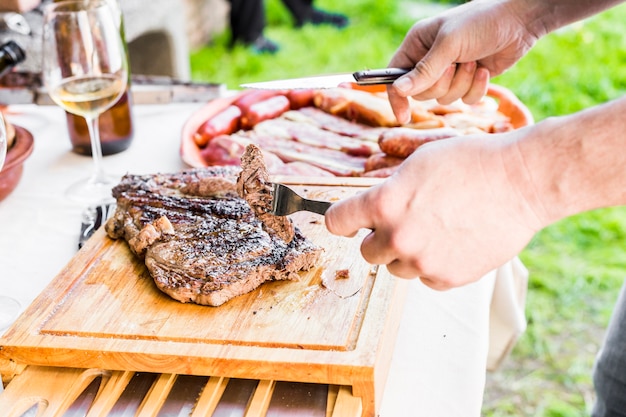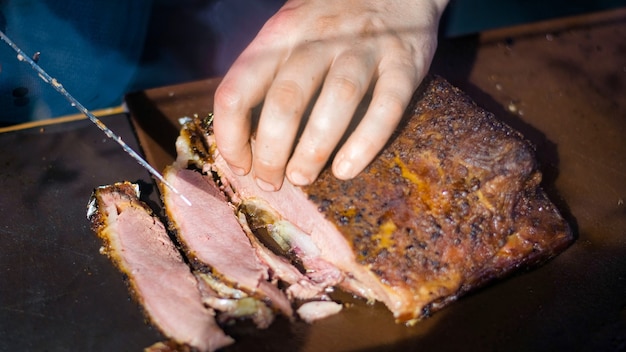Ah, prime rib. The mere mention sends shivers of delicious anticipation down my spine. It's not just a roast; it's an event, a celebration of culinary excellence. But figuring out the cooking time for this magnificent cut of beef can be a bit of a head-scratcher. It's like trying to solve a culinary puzzle, with variables like bone-in versus boneless, desired doneness, and the ever-important resting time all playing a part. Well, fret no more, my fellow food enthusiasts, because I'm about to unveil the secrets to achieving prime rib perfection, from choosing the right cut to carving it with finesse. Buckle up, because we're diving deep into the world of prime rib cooking!
(Part 1) The Prime Rib: A Culinary Masterpiece

Let's start by acknowledging the star of the show: prime rib. This cut, taken from the rib section of a beef carcass, is renowned for its rich marbling – those little veins of fat that render the meat incredibly tender and succulent. The marbling creates an almost buttery texture that melts in your mouth, delivering a symphony of flavor. Now, the word "prime" in prime rib doesn't just signify quality; it's a specific cut, a section of ribs that's prized for its tenderness and flavor.
Choosing the Right Cut
The first decision you'll need to make is the size of your prime rib. For a casual gathering of 6-8 people, a 3-4 bone roast will be ample. But if you're hosting a grand dinner party for 10-12 guests, a 5-6 bone roast is the way to go. Don't be afraid to seek guidance from your butcher. They can help you select the right size and grade of beef, and they're always a wealth of information. Personally, I'm a big fan of "choice" grade prime rib. It's a bit more budget-friendly than "prime" grade, yet still delivers an exceptional level of tenderness and flavor. But if you're feeling fancy, go ahead and splurge for "prime" – you're worth it!
Understanding the Bone: More Than Just a Structure
Now, let's talk about the bone, that iconic element of a prime rib roast. It's not just there for structural support, folks. The bone plays a crucial role in the cooking process, acting like a natural thermometer and retaining moisture. This results in a juicy and flavorful roast that's simply unbeatable. Think of it as a secret weapon, adding a depth of flavor you won't find in boneless roasts. Plus, those bone-in pieces make for a stunning presentation on your serving platter.
(Part 2) Getting Ready for the Roast: A Culinary Pre-Game

You've got your prime rib – now it's time to get ready for the cooking process. Think of this as the "pre-game" – setting the stage for a culinary masterpiece. A little bit of planning goes a long way in achieving a perfect roast.
Prepping the Roast: Seasoning is Key
Start by patting your prime rib dry with paper towels. We want that surface nice and dry to help create a beautiful, crispy crust. Next, generously season the roast with salt and pepper. This is your foundation, so don't skimp! Now, let's get creative. Feel free to add your favorite seasonings, like garlic powder, onion powder, rosemary, or a blend of herbs. It's all about personal preference. I like to add a pinch of paprika for a touch of color and flavor.
Choosing Your Cooking Weapon: Oven, slow cooker, or Smoker?
Now, the fun part – deciding how you'll conquer this culinary challenge. You have a few options at your disposal:
- Oven: The classic and dependable choice. This method provides consistent heat and allows for precise temperature control, ensuring a perfect roast. Just remember to preheat your oven thoroughly and maintain a steady temperature throughout the cooking process.
- Slow Cooker: For a hands-off approach and a melt-in-your-mouth tender roast, the slow cooker is a fantastic option. However, keep in mind that you might not achieve that crispy crust you crave with this method.
- Smoker: If you're after that smoky, deep flavor profile that elevates a prime rib to new heights, the smoker is your go-to. It adds a unique dimension of taste that will impress your guests.
I'm a creature of habit and usually stick with my trusty oven. But hey, culinary exploration is encouraged! Feel free to experiment and discover your own favorite method.
(Part 3) The Big Reveal: Cooking Time and the Temperature Guide

Here comes the moment of truth: figuring out the cooking time for your bone-in prime rib. Remember, this isn't your average roast, so we need to adjust our approach.
Calculating Cooking Time: A General Rule of Thumb
For a bone-in roast, aim for a cooking time of around 15-20 minutes per pound at 325°F (160°C). This will generally result in a medium-rare roast, which is my personal preference. If you like your prime rib well done, you'll need to increase the cooking time accordingly.
Here's a quick table to visualize the cooking time:
| Roast Weight (lbs) | Cooking Time (mins) |
|---|---|
| 3 | 45-60 |
| 4 | 60-80 |
| 5 | 75-100 |
| 6 | 90-120 |
Remember, these are just guidelines. The actual cooking time will vary depending on the thickness and size of your roast, as well as the specific temperature of your oven.
internal temperature Guide: Doneness Made Easy
While the cooking time is a good starting point, the real measure of perfection lies in the internal temperature of your prime rib. A trusty meat thermometer is your culinary sidekick, ensuring a safe and delicious roast.
| Internal Temperature (°F) | Doneness |
|---|---|
| 125-130 | Rare |
| 130-135 | Medium Rare |
| 135-140 | Medium |
| 140-145 | Medium Well |
| 145-150 | Well Done |
For a bone-in roast, insert the thermometer into the thickest part of the meat, avoiding the bone. You can also check the temperature in the center of the roast for a more accurate reading.
(Part 4) The Art of Resting: Let It Relax and Redistribute
Once your prime rib is cooked to perfection, it's time for a well-deserved rest. This crucial step allows the juices to redistribute evenly throughout the roast, resulting in a more tender and flavorful cut. Think of it as a chance for the prime rib to relax after its journey through the oven.
The Resting Period: Patience Pays Off
I recommend resting your prime rib for at least 30 minutes before carving. Cover it loosely with foil to keep it warm and prevent it from drying out. While it's resting, you can get your sides ready. I like to serve my prime rib with roasted vegetables, creamy mashed potatoes, and a rich gravy, but feel free to indulge your creative side with your favorite pairings.
(Part 5) The Big Finale: Carving and Serving with Finesse
The time has arrived! The prime rib is rested, the sides are ready, and anticipation is in the air. It's time to unleash your inner carving maestro.
Carving Tips: From Beginner to Master
Here are a few pointers to make your carving experience smooth and successful:
- Use a Sharp Carving Knife: You want a knife that cuts through the meat with ease, without tearing or shredding it. A good carving knife is an investment worth making.
- Cut Against the Grain: This will make the meat tender and easy to chew, enhancing the overall dining experience.
- Carve Thin Slices: You want your guests to savor the flavor of the prime rib, so avoid thick slices. Thin slices allow the flavor to shine through and make for a more enjoyable experience.
Serving Suggestions: Presenting a Culinary Masterpiece
Once you've carved your prime rib, arrange the slices on a platter, with the bone-in centerpieces strategically placed. This creates a visually stunning presentation and ensures that everyone gets a taste of the juicy meat. Serve with your chosen sides, and don't forget that essential touch – a rich, flavorful gravy.
(Part 6) Mastering the Art of Roasting: Elevate Your Prime Rib Game
Now that you've got the foundation down, let's delve into some insider tips and tricks to elevate your prime rib game from good to extraordinary. These are my personal secrets for achieving a truly memorable roast.
The Importance of Even Cooking: Achieving Perfection
Even cooking is paramount for a perfect prime rib. We want every single part of the roast to reach the desired internal temperature, avoiding any hot spots or undercooked areas. To ensure this, it's crucial to preheat your oven properly and maintain a consistent temperature throughout the cooking process.
Basting for Extra Flavor and Moisture: A Culinary Touch
Basting your prime rib during the roasting process is a fantastic way to keep it moist and tender. A simple basting solution can be made with melted butter, or you can get more creative with a mixture of butter and herbs. I personally love a combination of butter, garlic, and rosemary for a burst of flavor.
The Final Touch: Crispy Crust for Extra Crunch and Flavor
We all crave that irresistible crispy, golden crust on a prime rib, right? It adds a satisfying crunch and enhances the flavor of the roast. Here's how to achieve that coveted crust:
- Searing Before Roasting: Searing the prime rib in a hot skillet before roasting creates a beautiful crust and seals in the juices.
- High Heat Finish: For the last 15-20 minutes of cooking, crank up the oven temperature to 450°F (230°C). This will help to brown the exterior and create a crispy, flavorful crust.
(Part 7) prime rib faqs: Answering Your Culinary Questions
Let's address some common questions about prime rib cooking.
1. Can I Cook Prime Rib in the Slow Cooker?
Absolutely! The slow cooker is a fantastic option for a hands-off approach and results in a very tender roast. Just keep in mind that you might not get that crispy crust you'd achieve with oven roasting.
2. How Long Should I Cook Prime Rib at 350°F?
For a bone-in prime rib, the general cooking time at 350°F (175°C) is 15-20 minutes per pound. However, it's crucial to use a meat thermometer to check the internal temperature and ensure it's cooked to your desired doneness.
3. How Do I Reheat Prime Rib?
To reheat prime rib, you can use the oven or a skillet. Preheat your oven to 325°F (160°C) and heat the prime rib for 15-20 minutes, or until it's heated through. You can also reheat it in a skillet over medium heat, basting it with butter or broth for extra moisture.
4. What Are Some Good side dishes for Prime Rib?
Prime rib pairs beautifully with a variety of sides. Some of my personal favorites include roasted vegetables, creamy mashed potatoes, polenta, Yorkshire pudding, and a rich, flavorful gravy.
5. Can I Freeze Prime Rib?
Yes, you can freeze prime rib for up to 3-4 months. To freeze it, wrap it tightly in plastic wrap and aluminum foil. When you're ready to use it, thaw it in the refrigerator for 2-3 days.
(Part 8) Final Thoughts: A culinary journey
Cooking a perfect prime rib is a culinary journey, a testament to your skills and dedication. It requires a bit of planning, a touch of patience, and a dash of culinary confidence. But believe me, the reward is well worth the effort. The aroma of the roasting meat, the satisfying sizzle of the crust, the tender, juicy slices – it's a dining experience that will leave your guests in awe. So go forth, my friends, and unleash your inner culinary maestro. You've got this!
Everyone is watching

Corn on the Cob: The Ultimate Guide to Perfectly Cooked Ears
Healthy MealsAh, corn on the cob. Just the name evokes images of sunny days, barbecues, and that sweet, juicy flavour that ...

Perfect Pork Roast Oven Cooking Time: A Guide to Delicious Results
Healthy MealsThere's something truly satisfying about a perfectly roasted pork. The aroma alone is enough to make your mout...

Ham Cooking Time: How Long to Bake, Smoke, or Boil a Delicious Ham
Healthy MealsAh, ham. It's a classic, isn't it? A real crowd-pleaser, especially around holidays. And when done right, it'...

Scallops: The Ultimate Guide to Perfect Cooking
Healthy MealsAh, scallops. Those delicate, sweet, and utterly delicious morsels of the sea. They hold a special place in my...

Spaghetti Squash: The Ultimate Guide to Cooking and Serving
Healthy MealsRemember that time you saw spaghetti squash at the supermarket, looking all bumpy and strange, and thought, "W...
